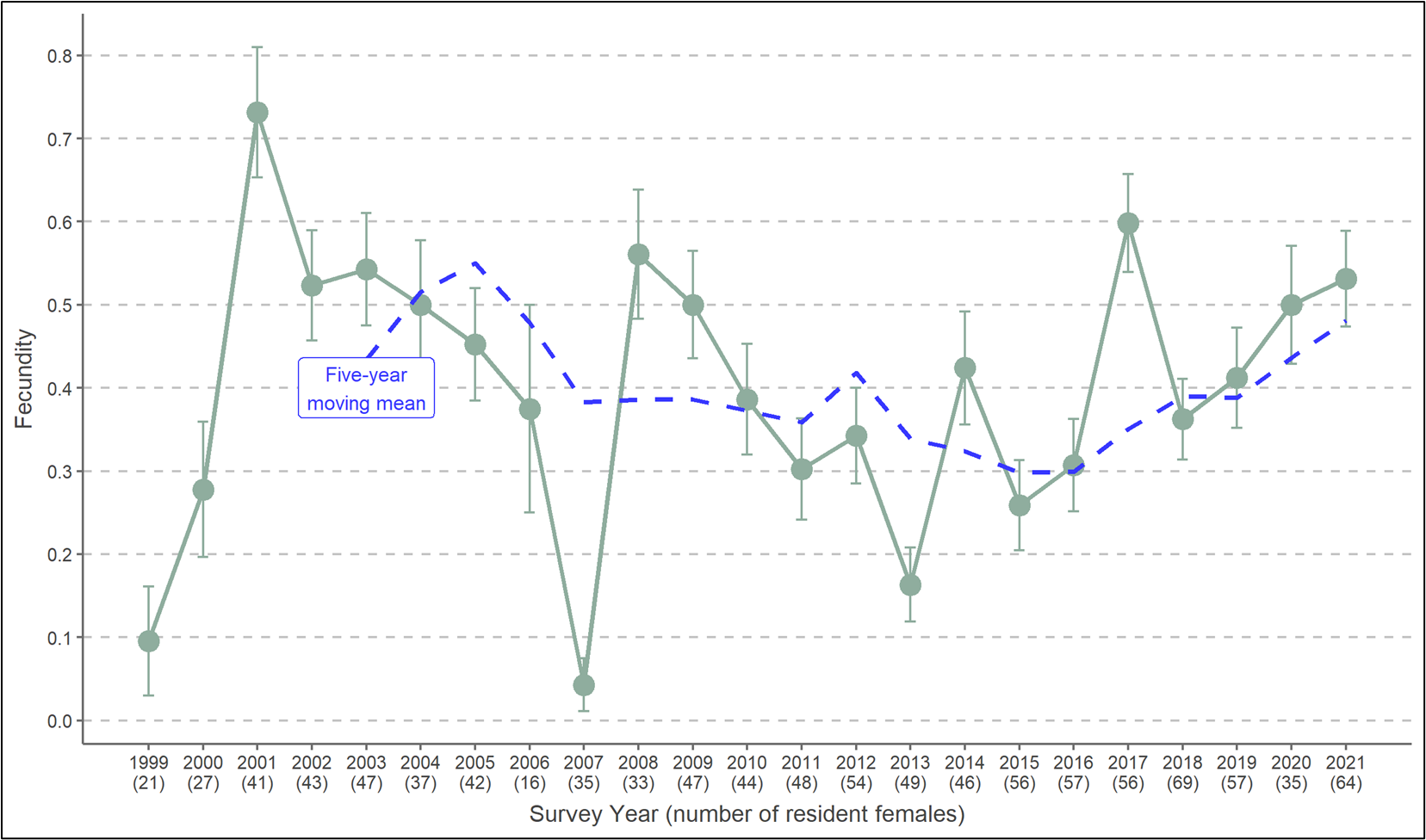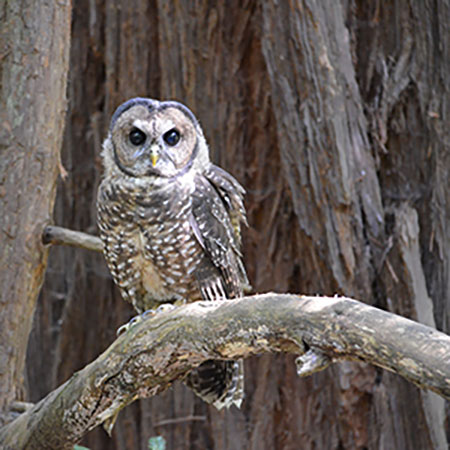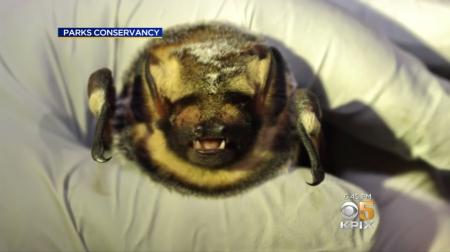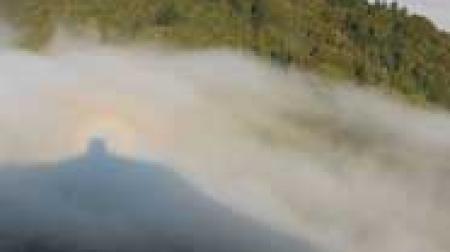Why Was This Indicator Chosen?
Iconic and charismatic Northern Spotted Owls (Strix occidentalis caurina) are good indicators of Marin County’s forest health, as their success depends on the presence of diverse, robust evergreen forest ecosystems in this area. Northern Spotted Owls are important upper-level predators that feed on a variety of rodents, especially dusky-footed woodrats (Neotoma fuscipes).
One Tam land management agencies have a wealth of inventory and long-term monitoring data on this species covering most of Marin County. Data on long-term trends in Northern Spotted Owl territory occupancy, reproductive success, and nesting habitat preferences help managers track population trends, avoid nesting season disturbances, and evaluate the impacts of potential threats including encroaching Barred Owls (S. varia), Sudden Oak Death (SOD), and climate change.
What is Healthy?
A healthy population of Northern Spotted Owls on Mt. Tam would remain stable or increase over time. Additionally, existing high levels of pair occupancy and fecundity would be maintained within the observed normal range of variability, or above long-term average values based on monitoring data. Lastly, the threat from Barred Owls would remain low.
What Are the Biggest Threats?
- Barred Owls, which negatively impact Northern Spotted Owl reproduction and survival
- Habitat quantity and quality, as Northern Spotted Owls will nest in areas of relatively high recreational use and residential areas where they may be exposed to noise disturbances and rodenticides
- The effects of SOD on forest structure and dusky-footed woodrat abundance
What is the Current Condition?
Listed as threatened in 1990 under the Endangered Species Act, Northern Spotted Owl numbers appear to be dramatically decreasing across their range, which extends from southern British Columbia to Marin County, California (Dugger et al., 2016). In contrast, Marin County’s Northern Spotted Owl population appears stable (Ellis, 2016; Cormier 2015).
Based on the metrics used for this health assessment, Northern Spotted Owls in the One Tam area of focus are in Good condition. Over the previous five years surveyed (2017-2021), pair occupancy of territories ranged from 78–86% of nests, depending on the year, with an average pair occupancy of 83%. Fecundity increased over the previous five-year average. The Barred Owl has been detected in low numbers (at two to five Spotted Owl-monitored sites) in the past five years (2018–2022), and their overall numbers are similar to the 2016 Peak Health assessment.
What is the Current Trend?
This species is showing No Change.
How Sure Are We?
Confidence is High, as Northern Spotted Owls are monitored on an annual basis within and adjacent to Mt. Tam on both National Park Service and California State Park lands, as well as by Point Blue Conservation Science on and adjacent to Marin Municipal Water District and Marin County Parks lands.
What is This Assessment Based On?
- Inventories begun in the late 1980s (unpublished data), and continued in the early 1990s, with more complete inventories completed in 1997 and 1998, and again in 2006 for National Park Service and California State Park lands (Hatch et al., 1999, Jensen et al., 2007)
- Annual monitoring of Northern Spotted Owls in Marin County since 1999, with the National Park Service covering federal and state park lands and Point Blue monitoring on Marin Municipal Water District and Marin County Parks property
What Don’t We Know?
Key information gaps include:
- The effect of SOD on Northern Spotted Owl foraging or its primary food item, the dusky-footed woodrat
- The impacts of climate change on Northern Spotted Owl fecundity, survivorship, or habitat
- Factors affecting fecundity in the One Tam area of focus such as weather and climate, landscape and habitat factors, and any future presence of Barred Owls
- Dispersal patterns of juveniles
- Dusky-footed woodrat abundance across Northern Spotted Owl sites
- Survivorship data (not collected since 2003)
resources
Barrowclough, G. F., Growth, J. G., Mertz, L. A., & Gutiérrez, R. J. (2005). Genetic structure, introgression, and a narrow hybrid zone between Northern and California Spotted Owls (Strix occidentalis). Molecular Ecology, 14(4), 1109–1120. https://pubmed.ncbi.nlm.nih.gov/15773939
Carroll, C. (2010). Role of climatic niche models in focal-species-based conservation planning: Assessing potential effects of climate change on Northern Spotted Owl in the Pacific Northwest, USA. Biological Conservation, 143(6), 1432–1437. https://doi.org/10.1016/j.biocon.2010.03.018
Cormier, R. L. (2015). Northern Spotted Owl monitoring on Marin County Open Space District and Marin Municipal Water District lands [Report]. Point Blue Conservation Science.
Cormier, R. L. (2020). Northern Spotted Owl monitoring on Marin County Parks and Marin Municipal Water District lands [Report]. Point Blue Conservation Science.
Cormier, R. L., & Duncan, P. D. (2021). Northern Spotted Owl monitoring on Marin County Parks and Marin Municipal Water District lands [Report]. Point Blue Conservation Science.
Dugger, K. M., Forsman, E. D., Franklin, A. B., Davis, R. J., White, G. C., Schwarz, C. J., Burnham, K. P., Nichols, J. D., Hines, J. E., Yackulic, C. B., Doherty, Jr., P. F., Bailey, L., Clark, D. A., Ackers, S. H., Andrews, L. S., Augustine, B., Biswell, B. L., Blakesley, J. Carlson P. C., … Sovern, S. G. (2016). The effects of habitat, climate, and Barred Owls on long-term demography of Northern Spotted Owls. The Condor, 118(1), 57–116. https://doi.org/10.1650/CONDOR-15-24.1
Duncan, P. D., & Cormier, R. L. (2020). Barred Owl occupancy surveys on Marin County Parks lands in 2020: Report to Marin County Parks. Point Blue Conservation Science. https://tinyurl.com/4ve93pzt
Ellis, T. (2017). Monitoring Northern Spotted Owls on federal lands in Marin County, California: 2014- 2015 report (Natural Resources Technical Report NPS/SFAN/NRTR— 2017/1474). National Park Service. https://irma.nps.gov/DataStore/DownloadFile/581142
Ellis T. D. (2020). Monitoring Northern Spotted Owls on federal lands in Marin County, California: 2018 report (Natural Resource Report. NPS/SFAN/NRR—2020/2088). National Park Service. https://irma.nps.gov/DataStore/DownloadFile/637239
Evens, J. (1993). The natural history of the Point Reyes Peninsula. Point Reyes National Seashore Association.
Franklin, A. B., Dugger, K. M., Lesmeister, D. B., Davis, R. J., Wiens, J. D., White, G. C., Nichols, J. D., Hines, J. E., Yackulic, C. B., Schwarz, C. J., Ackers, S. H., Andrew, L. S., Bailey, L. L., Brown, R., Burgher, J., Burnham, K. P., Carlson, P. C., Chestnut, T., Conner, M. M., …Wise, H. (2021). Range-wide declines of Northern Spotted Owl populations in the Pacific Northwest: A meta-analysis. Biological Conservation, 259, 109168. https://doi.org/10.1016/j.biocon.2021.109168
Gabriel, M. W., Diller, L. V., Dumbacher, J. P., Wengert, G. M., Higley, J. M., Poppenga, R. H., & Mendia, S. (2018). Exposure to rodenticides in Northern Spotted and Barred Owls on remote forest lands in northwestern California: Evidence of food web contamination. Avian Conservation and Ecology, 13(1). https://doi.org/10.5751/ACE-01134-130102
Gardali, T., Seavy, N. E., DiGaudio, R. T., & Comrack, L. A. (2012). A climate change vulnerability assessment of California’s at-risk birds. PLoS ONE, 7(3), e29507. http://dx.doi.org/10.1371/journal.pone.0029507
Glenn, E. M., Anthony, R. G, Forsman, E. D., & Olson, G. S. (2011). Reproduction of Northern Spotted Owls: The role of local weather and regional climate. Journal of Wildlife Management, 75(6), 1279–1294. https://doi.org/10.1002/jwmg.177
Golden Gate National Parks Conservancy [GGNPC], Tukman Geospatial & Aerial Information Systems. (2021). 2018 Marin County fine scale vegetation map datasheet. Tamalpais Lands Collaborative (One Tam). https://tukmangeospatial.egnyte.com/dl/uQhGjac1zw
Hayward, L. S., Bowles, A. E., Ha, J. C., & Wasser, S. K. (2011). Impacts of acute and long-term vehicle exposure on physiological and reproductive success of the Northern Spotted Owl. Ecosphere, 2(6), 1–20. https://doi.org/10.1890/ES10-00199.1
Hofstadter, D. F. (2022). Barred Owl genetics, diet, and exposure to rodenticides [Unpublished data set].
Hofstadter, D. F., Kryshak, N. F., Gabriel, M. W., Wood, C. M., Wengert, G. M., Dotters, B. P., Roberts, K. N., Fountain, E. D., Kelly, K. G., Keane, J. J., Whitmore, S. A., Berigan, W. J., & Peery, M. Z. (2021). High rates of anticoagulant rodenticide exposure in California Barred Owls are associated with the wildland-urban interface. Ornithological Applications, 123(4). https://doi.org/10.1093/ornithapp/duab036
Jennings, S., Cormier, R., Gardali, T., Press, D., & Merkle, W. (2011). Status and distribution of the Barred Owl in Marin County, California. Western Birds, 42(2), 103–110. https://tinyurl.com/2p8aa7m6
Kramer, A., Jones, G. M., Whitmore, S. A., Keane, J. J., Atuo, F. A., Dotters, B. P., Sawyer, S. C., Stock, S. L., Gutiérrez, R. J., & Peery, M. Z. (2021). California Spotted Owl habitat selection in a fire-managed landscape suggests conservation benefit of restoring historical fire regimes. Forest Ecology and Management, 479, 118576. https://doi.org/10.1016/j.foreco.2020.118576
Lesmeister, D. B., Jenkins, J. M. A., Ruff, Z. J., Davis, R. J., Appel, C. L, Thomas, A. D., Gremel, S., Press, D., Chestnut, T., Swingle, J. K., Wilson, T., Culp, D. C., Lambert, H., McCafferty, C., Wert, K., Henson, B., Platt, L., Rhea-Fournier, D., & Mitchell, S. (2022). Passive acoustic monitoring within the Northwest Forest Plan Area: 2021 Annual Report. U.S. Forest Service and National Park Service. https://tinyurl.com/2p98hr86
National Park Service [NPS]. (2022a). Northern Spotted Owl monitoring in Marin County [Unpublished data set].
National Park Service [NPS]. (2022b). Monitoring Northern Spotted Owls and Barred Owls with acoustic monitoring units [Unpublished data set].
Olson, G. S., Anthony, R. G., Forsman, E. D., Ackers, S. H., Loschl, P. J., Reid, J. A., Dugger, K. M., Glenn, E. M., & Ripple, W. J. (2005). Modelling of site occupancy dynamics for Northern Spotted Owls, with emphasis on the effects of Barred Owls. Journal of Wildlife Management, 69(3), 918–932. https://www.jstor.org/stable/3803333?origin=JSTOR-pdf
Point Blue Conservation Science. (2021). Northern Spotted Owl monitoring in Marin County [Unpublished data set].
Press, D., Adams, D., Jensen, H., Fehring, K., Merkle, W., Koenen, M., & Starcevich, L. A. (2010). San Francisco Bay Area network Northern Spotted Owl monitoring protocol (Version 6.4; Natural Resource Report NPS/SFAN/NRR—2010/245). National Park Service.
Roberts, S. L., van Wagtendonk, J. W., Miles, A. K., & Kelt, D. A. (2011). Effects of fire on Spotted Owl site occupancy in a late-successional forest. Biological Conservation, 144(1), 610–619. https://doi.org/10.1016/j.biocon.2010.11.002
Schofield, L. N., Eyes, S. A., Siegel, R. B., & Stock, S. L. (2020). Habitat selection by spotted owls after a megafire in Yosemite National Park. Forest Ecology and Management, 478, 118511. https://doi.org/10.1016/j.foreco.2020.118511
Stralberg, D., Fehring, K. E., Nur, N., Pomara, L. Y., Adams D. B., Hatch D., Geupel, G. R., & Allen, S. (2009). Modeling nest-site occurrence for the Northern Spotted Owl at its southern range limit in central California. Landscape and Urban Planning, 90(1–2),76–85. https://doi.org/10.1016/j.landurbplan.2008.10.014
Swei, A., Ostfeld, R. S., Lane, R. S., & Briggs, C. J. (2011). Effects of an invasive forest pathogen on abundance of ticks and their vertebrate hosts in a California lyme disease focus. Oecologia, 166(1), 91–100. https://doi.org/10.1007/s00442-010-1796-9
U.S. Fish and Wildlife Service [USFWS]. (1990). Endangered and threatened wildlife and plants: Determination of threatened status for the Northern Spotted Owl (Final Rule), 50 C.F.R. §17. https://www.fws.gov/sites/default/files/federal_register_document/FR-1990-06-26.pdf
U.S. Fish and Wildlife Service [USFWS]. (2011). Revised recovery plan for the Northern Spotted Owl (Strix occidentalis caurina). https://www.govinfo.gov/content/pkg/FR-2011-07-01/pdf/2011-16456.pdf
U.S. Fish and Wildlife Service [USFWS]. (2012). Protocol for surveying proposed management activities that may impact Northern Spotted Owls (Released February 2, 2011, revised January 9, 2012). https://www.fws.gov/sites/default/files/documents/survey-protocol-for-northern-spotted-owl.pdf
Wan, H. Y., Cushman, S. A., & Ganey, J. L. (2019). Recent and projected future wildfire trends across the ranges of three Spotted Owl subspecies under climate change. Frontiers in Ecology and Evolution. https://doi.org/10.3389/fevo.2019.00037
Wiens, J. D., Dugger, K. M., Higley, J. M., Lesmeister, D. B., Franklin, A. B., Hamm, K. A., White, G. C., Dilione, K. E., Simon, D. C., Bown, R. R., Carlson, P. C., Yackulic, C. B., Nichols, J. D., Hines, J. E., Davis, R. J., Lamphear, D. W., McCafferty, C., McDonald, T. L., & Sovern, S. G. (2021). Invader removal triggers competitive release in a threatened avian predator. Proceedings of the National Academy of Sciences [PNAS], 118(31). e2102859118. https://doi.org/10.1073/pnas.2102859118




